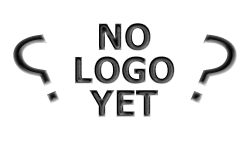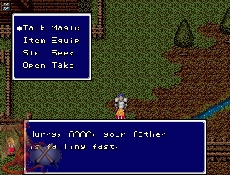|
|

|
BATTLE SYSTEM
|

|
INTERACTION
|

|
ORIGINALITY
|

|
STORY
|

|
MUSIC & SOUND
|

|
VISUALS
|

|
CHALLENGE
|
Insufferable
|
COMPLETION TIME
|
25-35 hours
|
|
OVERALL
1.0/5
|
Rating definitions
|
|
|
Some games age well and are highly regarded years after their making. Some don’t hold up as well but are still reasonably enjoyable years after their release. There are also games like Sword of Vermilion: games that are looked back upon through nostalgic memories that would fall apart in actually trying to play the thing again. Sword of Vermilion does a lot of things badly and only a few surpass that status to achieve the oh-so-grand rating of ‘below average.’ This was one of the first RPGs for the Sega Genesis in 1989: pity the poor player finished with Phantasy Star II and seeking something different on the system back then.
A good story was uncommon in the era Sword of Vermilion was released, and the game does nothing to forward the cause of narratives anywhere. The evil Tsarkon has gone on a conquering rampage after 8 evil rings came into his possession, and a loyal knight has taken the baby prince of the kingdom into hiding. 18 years later it is time for the prince to go off and grab the 8 good rings to combat Tsarkon. Essentially, that is the story. The prince never says anything, there isn’t much conversation at all and nothing more of a plot twist than a few Evil people posing as something else. The localization isn’t bad for 1989, but the source didn’t leave any room for interest.
 Even if this was legible, it wouldn’t be interesting.
Even if this was legible, it wouldn’t be interesting.
|
|
There are four views of the world in Sword of Vermilion: one for towns, one for wandering the world between towns, one for fighting, and one for boss battles. The town view is most typical of RPGs in that the camera is far overhead and the player can see the prince moving around. The prince moves slowly in town but otherwise it is acceptable. Far more problematic is the view while wandering the world. This has a screen in the top-left showing the prince moving square-by-square around, with a smaller window in the top-right displaying what is directly in front of the prince. The rest of the screen is taken up with statistics that the player probably does not want to see all the time, but will anyway. Up moves the prince forward, down moves him back, and left-right shift his facing posture. Getting used to this will take quite awhile, and every movement (even those that do not shift the prince to another spot on the map) carries the chance of spawning a random monster fight, as shown when a monster appears in the top-right window.
Fights are essentially a button-mash festival, but a terrible one. The prince and up to 8 enemies (always of the same type) appear on a piece of ground with an overhead view. The prince then swings his sword in one of the four cardinal directions and, if he is close enough to an enemy, hits it. Most enemies attack by trying to ram into the prince, so getting close to the enemy is an exercise in slamming onto the attack button with the hope of making the enemy run away for a bit instead of slamming into the prince. Magic is used with another button, and it takes the form of an attack that can hit enemies at a distance with varying parameters. Some enemies cannot be beaten without taking damage or using magic, and of course magic point-restoring items are expensive and rare. Fortunately running away is accomplished by getting to the side of the screen and walking off, with no penalty. Post-battle experience and money will be awarded, although figuring out how much is a memory exercise because there are no menus at all during battle – no way to pause, no way to see enemy statistics, and no notifications of how much experience and gold were just given. Also, items cannot be used in battle.
This does not address boss battles, which are something else entirely. As fighting games were in their infancy in 1989, a comparison would not be fair – but I’ll do one anyway. Think of the worst fighting game ever, and Sword of Vermilion’s boss battles would probably look like it. They take place with a 2D view akin to all 2D fighting games, except the prince cannot jump. Or turn around. Or use magic. Or use items. All the prince can do is walk forward (facing right), swing his sword, and duck.
 Cumbersome menu? Most definitely. Get used to it though.
Cumbersome menu? Most definitely. Get used to it though.
|
|
Battling and exploring are already irritating enough, but further interaction issues are easily found. Naturally when new equipment is found the player will have to do some mental math to figure out the difference in statistics granted; this was not unusual at the time. Having a limit of 8 items, however, is infuriating – particularly when healing magic will most likely run out before the player achieves a level-up. Each new area of the world requires a map or else the player can only see a tiny circle around the prince with the rest blacked-out. Dungeons not only need maps to navigate, but also a lantern (there is a magic spell to free up precious inventory space from this duty) or else nothing can be seen at all save the prince. The simple act of opening a treasure chest is annoying because of the need to not only access ‘open’ from the menu, but also to select ‘take’ afterwards. Forgetting to ‘take’ the item means it will sit there forever.
The magic system is annoying also. The player will buy spells for the prince in towns; but he has a limit of 8 at any one time. Also, only attack spells can be used in a fight and only one attack spell at a time is usable. Healing and other magic can only be used outside of battle. Establishing which enemy is appearing in a battle can be difficult thanks to the use of palette-swaps that are almost identical. And in an example of incredible negligence, somehow the game forgets every time the player selects to put the text scrolling speed at ‘Fast.’ Once the player turns the system off and restarts the game, this must be done all over again (and text scrolls slowly enough at a fast speed).
Visuals in town are okay. The NES might have accommodated them, or it might not have. Boss battles are a little less impressive than Altered Beast, but not terrible (though the palette-swapping of multiple bosses is very lazy). Navigating the world is accompanied by graphics that would have been ugly on the NES and could probably have been achieved with the Atari 2600.
Review Archives
|









